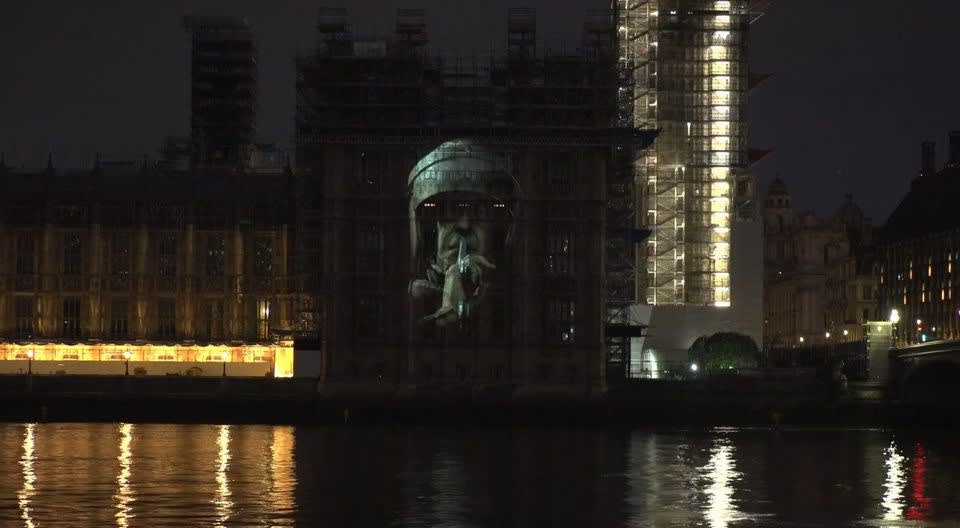
A few years ago (before the pandemic—remember that?), I would have written this kind of text with a firm hand and fanatism of an avant-garde manifest, indulging in the kind of manichean thinking we've often been accused of.
Jaime Cuenca suggested that it was better to see Democracia’s works than to listen to the authors, as our rigid political interpretation diminished the depth of the art. I don't dispute that. But now, honestly, I don't see many certainties anywhere, and tackling a reflection on political art can only be done through a few disjointed thoughts. However, these still hold some meaning for me, and maybe they might resonate with someone else too.
1. What I enjoy is painting flowers.
The members of the Irwin collective used to say that what they'd really like to do is paint flowers, not make "political art". They claimed they would turn to painting flowers once the Slovenian national question was resolved, perhaps pointing at something so unresolvable that it would sadly prevent them from ever painting the still life of flowers.
2. Labeled Art.
We've used the term "political art" purely for practical reasons, to quickly place ourselves within a certain context. However, nothing can truly be identified clearly under this label. In a time when everything becomes aestheticized, politics turns into spectacle, and this category, taken to its highest level of generalization, loses any specificity. When everything is political, nothing is political anymore. (Everything is maliciously transparent).
3. Vallecas.
In 2015, the Franco Resistance Days were held in Vallecas, an exhibition that, due to its content, resonated with the political sensitivity of the neighborhood. The residents themselves ended up transforming it into a popular antifascist event. It was them who gave it its true political dimension.
4. The Aesthetics of the 15M Movement and Sad Passions.
During the occupation of the squares, some believed they were witnessing the crystallization of a certain avant-garde-rooted utopia, which was becoming a kind of total artwork. Soon after, those chosen for their skills gathered on platforms and parties, trying to break through the glass ceilings of activism. This marked the beginning of the field of sad passions—the impotence of being unable to change anything, the affirmation of capitalist realism, the perpetuation of hierarchies, the creation of a new oligarchy, and the instrumentalization of art through its obligatory "social return".
5. The Far-Right Columnist and Vox Deputy.
He wrote, praising a performance by someone you thought was your ally. Alliances collapse, shift, change, and are forgotten. They are renounced.
6. The punk artist.
The punk artist holds a belief: in this rotten world where we are doomed to endless defeat, I can still make good money by shitting on it. The classic "Cash from Chaos" approach of the manager who leaves everyone else unpaid. However, Johnny Rotten said the secret of punk is that there shouldn't be difference between the audience and the musicians.
7. A young roma artist laughs.
She laughs at what she considers the pretentious flamenco industry, which empties it of content and social function. She says they haven't understood anything because they lack collective sentiment and only have egos.
8. The museum seeks photos in the anarchist archive for its new collection.
They are interested in an anarchist photographer, Margaret de Michaelis, but not in the series they believe aestheticizes misery. The archivists exchange glances; those photos were specifically commissioned by the union to depict the poverty of the working class, which now apparently is not in good taste to exhibit. The authorized contemporary perspective turns what was once a basic tool for advocacy into poverty porn.
9. On Our Instagram.
We announced a solidarity exhibition with the people of Palestine organized by Espacio Tangente. The goal is to generate resources to help and at least express opposition to the ethnic cleansing happening right in front of us, broadcasted in real-time. It didn't take long for an artist to comment, criticizing us for not explicitly including the intention to liberate Palestinians from Hamas occupation. We responded that the entire Western media and political apparatus is already doing that 24/7. "And the artists too”, he replied. It is a depressing mission for artists if what they have to do is reinforce the hegemonic thinking distributed from the centers of colonial power.
10. Ian Alan Paul en X
- “The celebrity was born in the world of Marx and Coca Cola, while the influencer came of age in the world of vaping and Guy Debord”.
- “I don't know if I agree (for me, right now, times are more Baudrillardian than Debordian), but the aphorism is a nice one”.
- “I remain somewhat ambivalent about Baudrillard's work. The critique always rings true, but there never seems to be any radical possibility left at the end”.
- “That's exactly why I think these times are more Baudrillardian”.
11 "The best struggle is the one that is hopeless".
We created that slogan for a public intervention in Barcelona, which was a tribute to the maquis Quico Sabaté. Erroneously, it has begun to be attributed to Sabaté himself in certain critical texts and essays. We have no evidence that he said it, but he could have easily said it.
12. "Tell me where you stand, and I'll tell you what political art you make."
This axiom, which I heard from Xose Quiroga, clears everything up. Apply it, and then we'll know what we're talking about.

